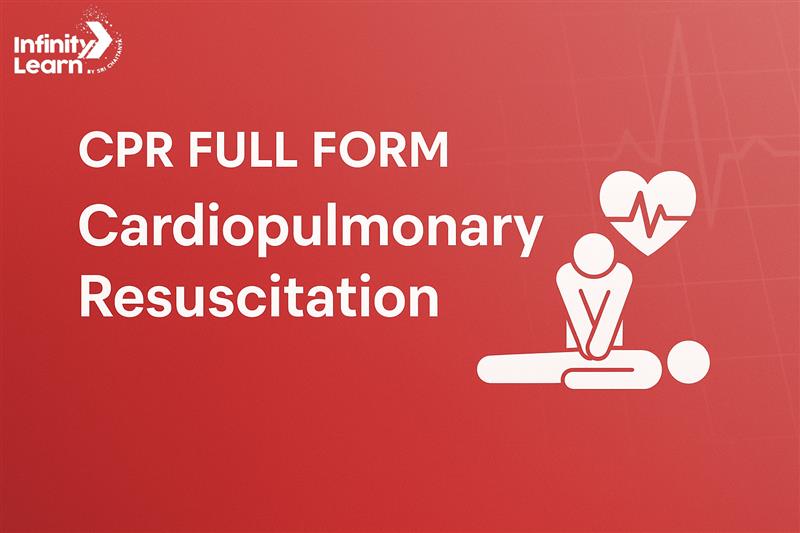Table of Contents
CPR full form is Cardiopulmonary Resuscitation. “Resuscitation” refers to bringing someone back to life, “cardio” refers to the heart, and “pulmonary” refers to the lungs. When a heart attack or cardiac arrest occurs, CPR is a life-saving technique. A heart condition, drowning, suffocation, or electric shock can all cause cardiac arrest.
CPR includes two crucial procedures: chest compressions, which help maintain the flow of oxygen-rich blood throughout the body until the heart and breathing function normally again, and rescue breathing, which supplies oxygen to the lungs.

CPR Full Form
The full form of CPR is Cardiopulmonary Resuscitation.
What Is the Purpose of CPR?
When a person’s heart stops beating or malfunctions, cardiopulmonary resuscitation (CPR) is performed to help save their life. We refer to this as a cardiac arrest. The brain and other vital organs cannot receive blood when the heart stops beating.
Many people deal with this severe issue each year. CPR, however, can be beneficial! The person has a better chance of surviving if someone nearby is trained in CPR and responds promptly. CPR can actually increase their chances of survival by two or even three times.
Do Check: TBT Full Form
CPR is not only for doctors. Anyone can learn it! The Red Cross and other groups teach people how to do CPR in a safe and easy way. When you learn CPR, you’ll know what to do in an emergency and can help someone when it really matters.
Why is CPR Important?
CPR is very important because it can help save someone’s life. You should use CPR if a person is not waking up and is not breathing or only making little gasping sounds.
What Are the Types of CPR?
There are two main types of CPR you can learn. Both are helpful and can save lives.
- Hands-Only CPR: A quick and easy technique that can save a life is hands-only cardiopulmonary resuscitation. To get emergency assistance, you should first dial 9-1-1. Ask someone to get an AED (a device that helps the heart) if one is close by. Next, begin applying chest compressions by rapidly and forcefully pressing in the centre of the chest without pausing. It only takes a few minutes to learn this kind of CPR.
- Full CPR With Rescue Breaths: While Hands-Only CPR is helpful, learning Full CPR is also very important. Full CPR means doing both chest compressions and rescue breaths (blowing air into the person’s mouth to help them breathe). Getting trained in full CPR can make you feel more confident and ready to help in many types of emergencies. It is good for people of all ages, especially for children and babies who may have trouble breathing.
Do Check: ABG Full Form
Benefits of Being CPR Certified
Getting CPR certified is one of the best ways to be prepared during an emergency. It gives you the power to help someone when every second counts.
- Emergencies Can Happen Anytime: Accidents and emergencies can happen anywhere at home, school, work, in the park, or even on an airplane. That’s why learning CPR before something happens is very important. CPR can help save a life if someone’s heart stops or they stop breathing.
- Every Second Matters: You might think, “Why learn CPR if I can just call 9-1-1?” Yes, calling 9-1-1 is very important, but help can take time to come. Each minute that goes by without CPR makes it harder for a person to survive. If someone nearby gives CPR quickly, it can greatly increase the person’s chance to stay alive.
- CPR Helps Protect the Brain: Even if someone’s life is saved, they can still get very sick if the brain doesn’t get oxygen in time. CPR helps keep blood and oxygen moving to the brain, which helps prevent brain damage or death.
- Anyone Can Learn CPR: The best part is that anyone, even kids and grown-ups, can learn CPR! It only takes a few hours, and classes are available on weekdays and weekends, in different ways, like in-person or online.
- Feel Ready to Help Anytime: When you learn CPR, you’ll feel confident and brave enough to help in an emergency. You’ll also get refresher materials online and a simple printable guide to remember all the CPR steps. That way, you’ll always have the help you need, right when you need it.
Do Check: ACC Full Form
Cardiac Arrest Chain of Survival
Cardiac arrest can happen anytime and anywhere at home, in school, or in public places. This happens when the heart stops beating or cannot pump blood properly to the brain and other important parts of the body. To help someone survive a cardiac arrest, there is a step-by-step process called the Chain of Survival. These steps are very important and can increase the chance of saving a life if followed quickly and correctly.
FAQs on CPR Full Form
What is 2 minutes of CPR?
It means giving chest compressions and rescue breaths for 2 minutes to help someone whose heart has stopped.
What CPR means?
CPR is a way to help someone breathe and get blood to their body when their heart stops.
What is the full form of CPR?
The full form of CPR is Cardiopulmonary Resuscitation.
What is the golden rule of CPR?
Always call 911 or ask someone to call 911 if a person collapses or needs CPR.








